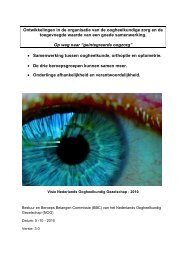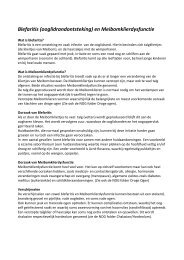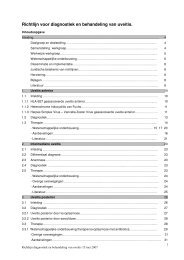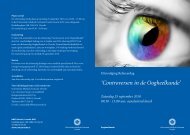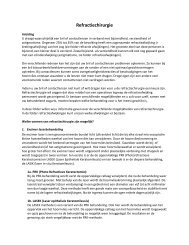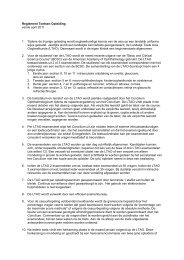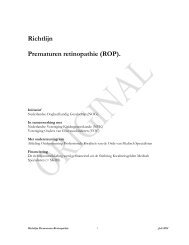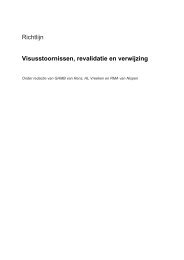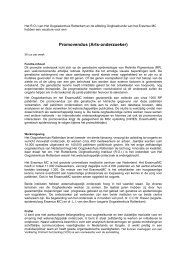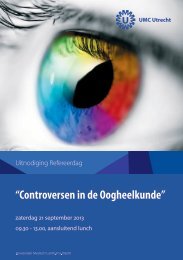terminology and guidelines for glaucoma ii - Kwaliteitskoepel
terminology and guidelines for glaucoma ii - Kwaliteitskoepel
terminology and guidelines for glaucoma ii - Kwaliteitskoepel
Create successful ePaper yourself
Turn your PDF publications into a flip-book with our unique Google optimized e-Paper software.
3.5.4 - CYCLOPHOTOCOAGULATION<br />
Indications<br />
When filtration surgery is likely to fail, has failed, or is not feasible.<br />
As an alternative to drainage devices.<br />
Trans scleral 90<br />
• Nd:YAG (1064 nm)<br />
Divided into contact <strong>and</strong> non-contact, as well as continuous wave <strong>and</strong> pulsed laser systems<br />
Non-contact: the laser energy is transmitted through air from a slit lamp delivery system<br />
Contact: transmission directly from the delivery system to the ocular surface via a fiberoptic h<strong>and</strong>-held<br />
probe placed on the conjunctiva<br />
Pulsed: transmits energy at relatively short, predetermined time intervals<br />
Continuous: allows longer sustained energy delivery with time intervals selected by the surgeon<br />
Technique:<br />
Peribulbar or retrobulbar injection of a 50:50 mixture of 2% lidocaine <strong>and</strong> 0.75% bupivicaine with<br />
hyaluronidase<br />
Shields’ trans-scleral lens<br />
Distance from limbus 1-3 mm (ciliary body should be localized with transillumination)<br />
Applications: 8-25 over 180°, energy 1.5-10J per pulse<br />
• Diode (810 nm)<br />
Technique:<br />
Peribulbar or retrobulbar injection of a 50:50 mixture of 2% lidocaine <strong>and</strong> 0.75% bupivicaine with hyaluronidase<br />
Distance from limbus 0.5-2.0 mm (ciliary body should be localized with transillumination)<br />
Applications: 10-20 over 180°, energy 5-6J per pulse, total treatment per session up to 270° of circumference<br />
(avoid 3 <strong>and</strong> 9 o`clock positions)<br />
Endoscopic<br />
Endoscopic techniques combined with laser technology allow the photocoagulation of ciliary processes not readily<br />
visible via the transpupillary route. The approach can be limbal or via the pars plana, using a fiberoptic probe<br />
- Argon laser<br />
- Diode laser<br />
Transpupillary<br />
This procedure is possible only in cases of aniridia, through a large surgical iridectomy or when broad peripheral<br />
anterior synechiae cause anterior displacement of the iris.<br />
- Argon laser<br />
- Diode laser<br />
Complications<br />
Persistent inflammation<br />
Loss of BCVA<br />
Phthisis<br />
Post-operative management<br />
Consider analgesia, topical steroids <strong>and</strong> topical atropine<br />
Ch. 3 - 32 EGS



